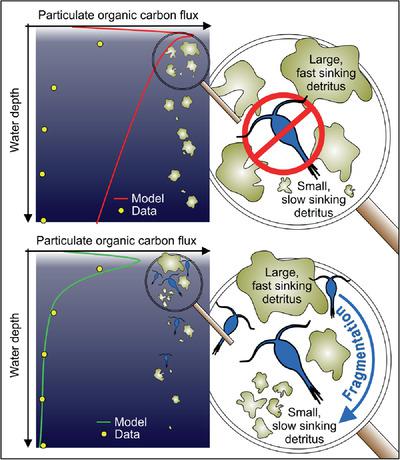Our official English website, www.x-mol.net, welcomes your
feedback! (Note: you will need to create a separate account there.)
Ocean carbon sequestration: Particle fragmentation by copepods as a significant unrecognised factor?
BioEssays ( IF 3.2 ) Pub Date : 2020-11-11 , DOI: 10.1002/bies.202000149 Daniel J Mayor 1 , Wendy C Gentleman 2 , Thomas R Anderson 3
BioEssays ( IF 3.2 ) Pub Date : 2020-11-11 , DOI: 10.1002/bies.202000149 Daniel J Mayor 1 , Wendy C Gentleman 2 , Thomas R Anderson 3
Affiliation

|
Ocean biology helps regulate global climate by fixing atmospheric CO2 and exporting it to deep waters as sinking detrital particles. New observations demonstrate that particle fragmentation is the principal factor controlling the depth to which these particles penetrate the ocean's interior, and hence how long the constituent carbon is sequestered from the atmosphere. The underlying cause is, however, poorly understood. We speculate that small, particle‐associated copepods, which intercept and inadvertently break up sinking particles as they search for attached protistan prey, are the principle agents of fragmentation in the ocean. We explore this idea using a new marine ecosystem model. Results indicate that explicitly representing particle fragmentation by copepods in biogeochemical models offers a step change in our ability to understand the future evolution of biologically‐mediated ocean carbon storage. Our findings highlight the need for improved understanding of the distribution, abundance, ecology and physiology of particle‐associated copepods.
中文翻译:

海洋碳固存:co足类的颗粒破碎是一个重要的未被认识的因素吗?
海洋生物学通过固定大气中的CO 2来帮助调节全球气候并将其作为沉渣碎屑出口到深水。新的观察结果表明,颗粒破碎是控制这些颗粒渗透到海洋内部的深度的主要因素,因此也是控制碳从大气中隔离多长时间的主要因素。但是,根本原因尚不清楚。我们推测,与颗粒相关的小co足类动物在寻找附着的原生动物猎物时会拦截并无意中破坏沉没的颗粒,是造成海洋碎裂的主要因素。我们使用新的海洋生态系统模型探索了这个想法。结果表明,在生物地球化学模型中用representing足类动物明确表示颗粒碎裂,使我们了解生物介导的海洋碳储存的未来发展的能力发生了巨大变化。
更新日期:2020-11-25
中文翻译:

海洋碳固存:co足类的颗粒破碎是一个重要的未被认识的因素吗?
海洋生物学通过固定大气中的CO 2来帮助调节全球气候并将其作为沉渣碎屑出口到深水。新的观察结果表明,颗粒破碎是控制这些颗粒渗透到海洋内部的深度的主要因素,因此也是控制碳从大气中隔离多长时间的主要因素。但是,根本原因尚不清楚。我们推测,与颗粒相关的小co足类动物在寻找附着的原生动物猎物时会拦截并无意中破坏沉没的颗粒,是造成海洋碎裂的主要因素。我们使用新的海洋生态系统模型探索了这个想法。结果表明,在生物地球化学模型中用representing足类动物明确表示颗粒碎裂,使我们了解生物介导的海洋碳储存的未来发展的能力发生了巨大变化。











































 京公网安备 11010802027423号
京公网安备 11010802027423号